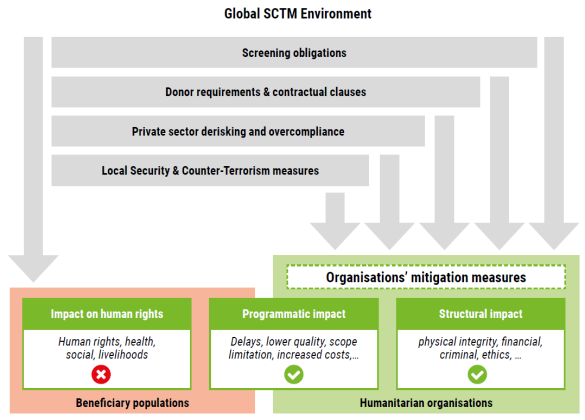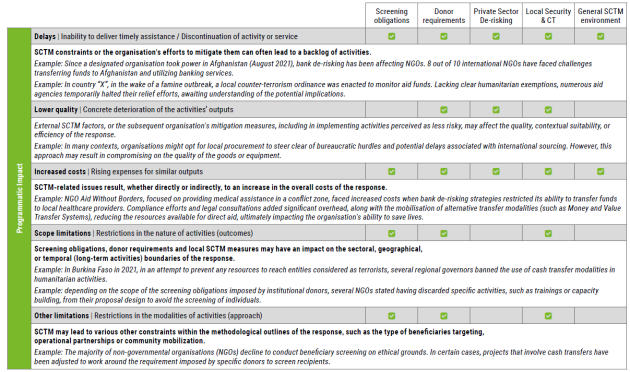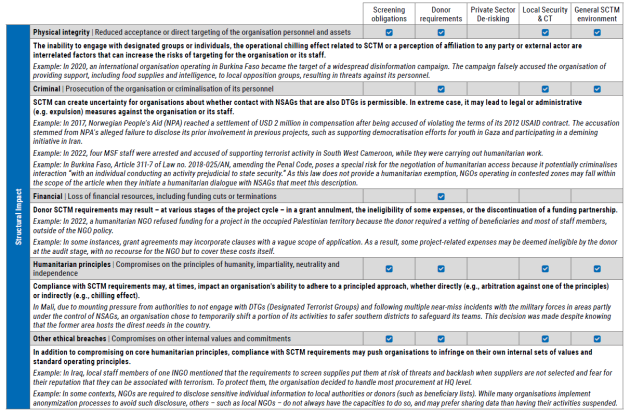Download Resources - English
The impacts of sanctions and counterterrorism measures: Data collection toolkit
6. Impacts and risks
Section 3 of these guidelines focused on the formalisation of issues and incidents that can stem from the global SCTM environment, and to analyse how they affect different parts of a humanitarian organisation. In doing so, it aimed at highlighting a first form of causal link: the consequences of the sanction and counter-terrorism normative
framework on daily operations. To complete this advocacy effort however, a second form of causal link must be demonstrated: the progression of issues and incidents into residual impacts.
These impacts are the final and unrecoverable consequences of SCTM on both humanitarian organisations and beneficiary populations, despite – and sometimes because of - the mitigation measures implemented by the organisation.
In the context of this framework, impacts are divided along three main categories:
- Programmatic impacts encompass all end consequences on the design, implementation and sustainability of humanitarian activities. As such, they affect both the aid agencies and beneficiary populations.
- Structural impacts, while not always affecting aid delivery directly, reverberate throughout the organisation or sector, and can lead to deeper fault points in the humanitarian mandate of the organisation.
- Impacts on human rights affect the wider well-being of beneficiary populations. To the exception of populations’ access to humanitarian assistance, it is for now not covered in this data collection scope.

Typology of impacts and risks


What information do we want to collect?

- While Program Coordinators are most relevant in reporting programmatic alterations, it can be challenging for them to determine the extent to which they are related to SCTM considerations. We recommend conducting this exercise in a focus group that includes collaborators from both program, support and senior management, and that may also mobilise the focal point (cf. tool J).
- Structural issues or incidents and their associated impacts or risks can sometimes overlap in terms of reporting. For instance, the arrest and indictment of humanitarian staff based on alleged support to terrorism can be categorised both as an incident and as an end impact by itself. The specific categorisation isn't critical, as long as the incident or impact is reported using one of the available tools.
- Self-evaluation: In addition to the incidents and issues register, the framework enables the Country Team
to analyse the most critical risks arising from SCTM constraints and issues (cf. tool J for further guidance).
Why do we want to collect this information?
One of the most critical aspects of SCTM-related advocacy is establishing the causal link between the international or local SCTM framework, the resulting issues and incidents, and their ultimate impact (or associated risks) on the humanitarian response and organisations. This latter link can be even more challenging to demonstrate because
issues and impacts are often experienced across different parts of an organisation. As a result, it is crucial to collect as many cases of programmatic and structural impacts as possible, whether they are actual or anticipated (risks), even
if their connection to SCTM constraints may initially seem distant.
- While it may not always be entirely possible to formally prove causality, by accumulating sufficient evidence clusters iteratively, advocacy teams can present a compelling case to external stakeholders. This may not prove causality definitively but can demonstrate strong trends.
- Concrete and quantifiable impacts, whether financial, ethical, physical, or leading to changes in assistance to populations, are also more effective in prompting organisations to recognise the significance of addressing SCTM
constraints. Internally, they hold greater weigh than a lengthy list of incidents and issues, which organisations often perceive as routine operational factors.
How can it be useful to operations?
Beyond advocacy purposes, flagging areas of impact of SCTM on the running of country-based operations may help prioritising mitigation measures:
- By identifying significant negative effects that could easily be mitigated through measures directly available to the Country Team (e.g. minor adjustments of operational modalities, interaction with a few key interlocutors).
- On the contrary, letting go of cumbersome mitigation measures towards issues that analytically prove to have minimal
consequences (in terms of likelihood or residual impact) on the organisation.
Tool J: Country Risks and Impact
Type: Survey
Tabs: Access, Grant, Partners, Finance, Procurement
The data collection tool was developed and designed by Action Against Hunger, Médecins du Monde, and Humanity & Inclusion.
